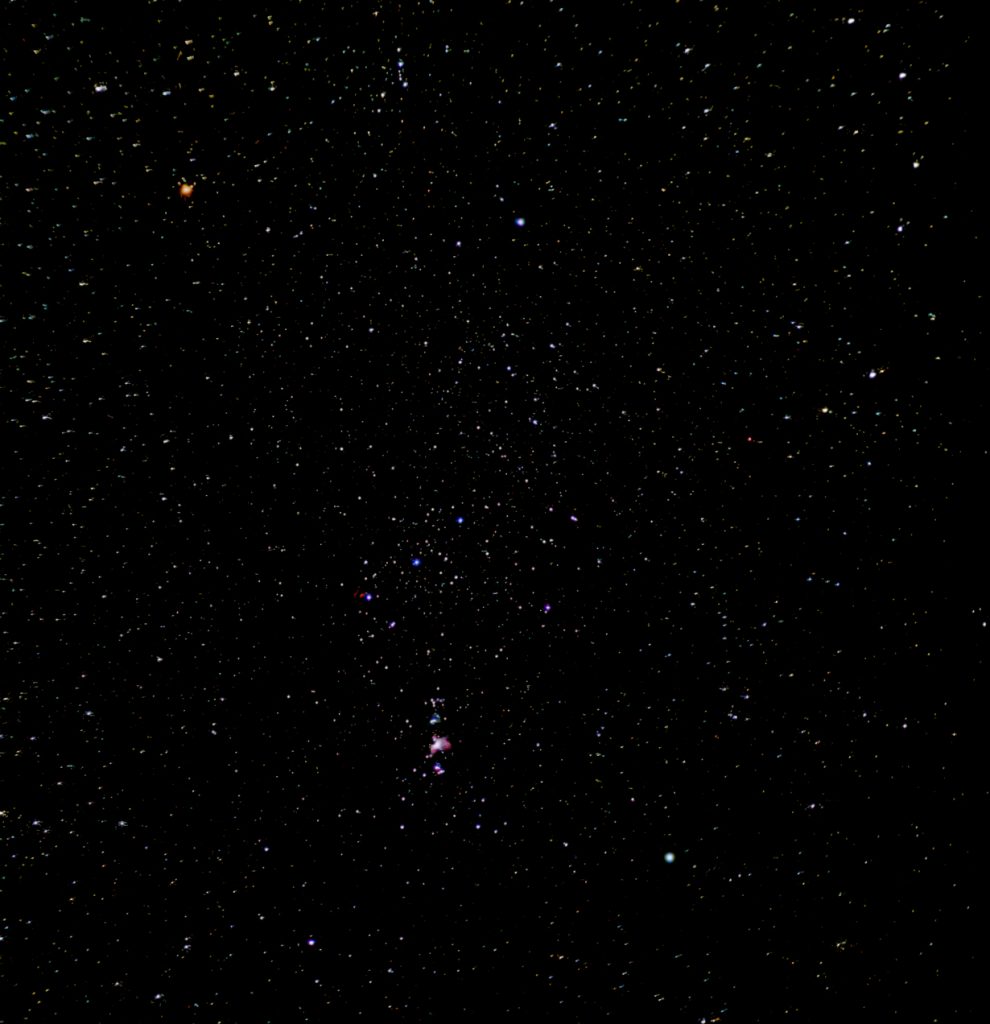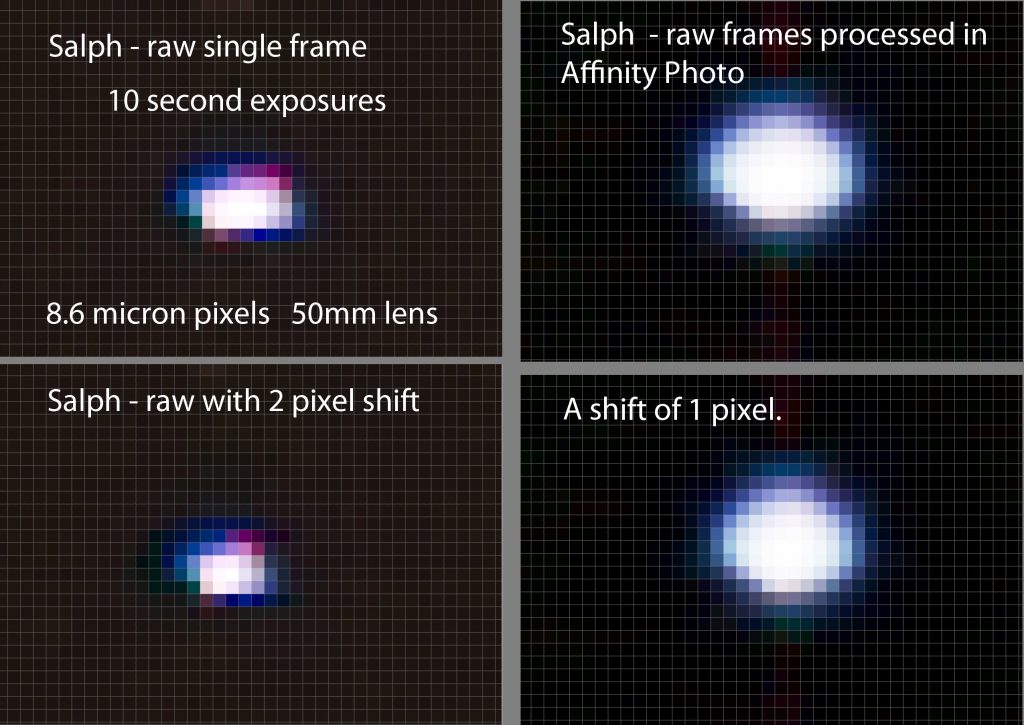APRIL 2022
The ‘500’ rule for imaging on a fixed tripod
[This is just one of many articles in the author’s Astronomy Digest.]
The image below is that of the Orion Constellation taken using a Sony A7S full frame, 12 megapixel, camera mounted on a fixed tripod. A 50 mm focal length lens was used stopped down to f/4 and an ISO of 800 was used. The exposure length was 10 seconds as determined by the ‘500’ rule for determining the maximum exposure length that can be used without significant star trailing being caused. It was taken as a test of this simple rule which is discussed below along with more accurate, but more complex, varients.

If a camera is used on a fixed tripod then, due to theEarth’s rotation, the stars being imaged will move across the camera’s sensor. The result is to cause ‘star trailing’. The 500 rule is used to determine the longestexposure that one can use with a given focal length lens so that this isprevented. One simply divides the focallength of the lens into 500. The ruleapplies to a lens mounted on a full frame camera. If, for example, the lens is mounted on anAPS-C sensor camera the actual focal length has to be multiplied by 1.6 for aCanon camera and 1.5 for all other cameras. For a Micro 4/3 camera the factor is 2. This is called the ‘crop factor’. So, for example, a 35 mm focal length lens mounted on a Nikon or SonyAPS-C sensor camera has an effective focal length of 52.5 mm and so the maximumexposure time would be ~10 seconds.
I think an easier way to consider this is to use instead;350 for cameras with APS-C sensors and 250 for Micro 4/3 cameras.
The motion of the stars across the sky (and hence sensor) isgreatest at the celestial equator and least at the celestial poles. So the basic time given by the 500 rule canbe increased by a factor of 1/Cos(Dec) – the declination of the constellation. Forexample, Cassiopeia is at Dec 60 so Cos(Dec) is 0.5 and 1/Cos(Dec) is 2, so theexposure time could be doubled.
So the ‘improved’ 500 rule is:
T = 500 / ((focal length ) x Cos(Dec)) for full frame cameras
T = 350 / ((focal length ) x Cos(Dec)) for APS-C cameras
T = 250 / ((focal length ) x Cos(Dec)) for Micro 4/3 cameras
Though the 500 rule could just be an empirical rule that ‘just’ works it can, however, bejustified theoretically.
1) It is determined by the Earth’s rotation which, at DecZero is 15 arc seconds per second.
2) The aperture of the lens which determines the size of theAiry Disk. Using a 50 mm lens at f/4,the aperture is 12.5 mm and the resolution ( ~size of the Airy Disk) is 9 arcseconds.
3) The atmospheric ‘seeing’ – typically 2 – 4 arc seconds.
From 2 and 3, the size of a stellar image on the sensor willbe around 10 – 12 arc seconds.
4) The pixel size of your camera which, typically, could befrom ~4 to 8 microns in size. For theSony A7S, 12 Megapixel full frame sensor camera this is ~8 microns = 0.008 mm. If we now assume a 50 mm lens, each pixelsubtends ((0.008/50) x 57.3 x 3,600) arcseconds. This is 33 arc seconds.
Let us suppose we are using this camera and 50 mm lens toimage the Orion Constellation. Orion liesat Dec zero so one simply divides 50 into 500 to get the suggested exposuretime of 10 seconds. During this exposure, the stars will have moved 10×15 =150 arc seconds so the star’s image will have moved across 4.5 pixels but, asthe stellar image is just over 1 pixel in size we might expect it to beelongated over 5 to 6 pixels. This iswhat is observed in the top left image of Figure 1 which is a single raw frameprocessed in Affinity Photo. The colourscould be scintillation effects as Salph, the lower left of the Orion brightstars, was at quite a low elevation. The upper right image is the aligned stack of 100 frames. The colour effects have nicely integrated outbut the stellar image is larger.

Trailing is apparent in both images. It is quite easy to correct for slighttrailing as in this case. In Photoshopor Affinity Photo (a superb low cost program) simply duplicate the image togive an upper layer. Choose ‘Darken’ asthe blending mode. Click on the ‘Move’tool and move over to the image and click again. (Otherwise the blending modemay change.) Then, using the arrow keysmove the top layer over the bottom layer and observe how the star trailing isreduced. Flatten or Merge the twolayers. In the case of the single framea move of 2 pixels gave the roundest image but, in the case of the stackedimage, just one.
So, in this case, using a camera with a low resolution sensoremploying a large pixel sensor, the 500 rule has worked pretty well.
With a high resolution sensor, one could well need to usewhat might be called the 400 or 300 rule instead as the trailing will be moreevident. However, as a little startrailing is easy to correct, it may be better to use the 500 rule and correctthe star trailing in post processing.
More complex formula
Frédéric Michaud of the Astronomical Society of Le Havre has studiedthis problem extensively:
https://sahavre.fr/wp/regle-npf-rule
Using Google Chrome, right clicking onthe page allows it to be translated into English.
He has produced formula which take intoaccount the aperture of the lens – whichwill determine the size of the Airy Disk for a stellar image on the sensor – and the pixel size of the sensor – smallerpixels will make star trailing more apparent.
There are several versions of increasingaccuracy. The simplest is:
100 x (4 – crop factor ) / ( focal lengthx cos(dec))
For a full frame camera this is simplythe ‘300’ rule and so gives an exposure of 6 seconds with a 50 mm lens atdec(0).
This seems quite conservative.
A more complex version is:
(35 x Aperture) + 30 x pixel size) / (focallength x cos(dec)) where the pixel sizeis in microns.
For a full frame sensor with 8 micronpixels this gives 8.2 seconds with a 50 mm focal length at an aperture of f/4.
This is almost the same as the mostcomplex formulation which gave an exposure of 7.8 seconds.
The website includes a built in calculator to derive the maximum exposure time for anycamera/lens/aperture combination.